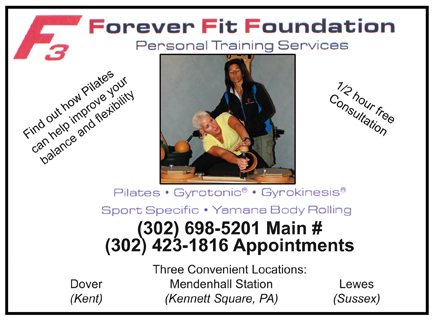Pilates’ Students Able To Take Lessons Off The Mat

By Nancy Hawkins Rigg, Founder and Owner, Forever Fit Foundation
Pilates offers an opportunity to improve strength, flexibility and balance. Students find themselves becoming longer and leaner and so much more. Pilates has invisible, intangible benefits . . . lessons for life that go way beyond the mat.
Consider, for example, balance. Balance is so much more than the ability to stand on one foot without falling. Balance is a state of equilibrium, serenity and calm. Balance is also associated with the ability to manage your life, to deal with challenges, to keep things in perspective, to handle adversity with a positive response. Practicing Pilates offers an opportunity to develop both physical and mental balance, and you’re never too old to practice this discipline of body, mind and spirit.
Pilates is an exercise system developed by Joseph Pilates, a German immigrant, who was a World War I prisoner of war in England, then moved to New York City in the 1920s. Rather than call his system with his own name, he named it Contrology because he believed in using the mind to control the muscles in order to develop strength and flexibility of the body and mind. Joseph Pilates believed strongly in the mind/body connection . . . balance and harmony. In the early years, Pilates’ principles were embraced by the dance community. The exercise system focuses on developing a strong core and a strong mind, and he created apparatus so that students could train their bodies. You really can’t execute the exercises without concentration, focus and control.
In today’s exercise world, Pilates has almost become a generic term that is frequently used by instructors who have not earned the credentials to properly train clients on the apparatus. Inquire about your trainer’s education for your own safety and ultimate success. Instructors must be trained to properly adjust springs and pulleys to individualize resistance training. A credentialed trainer will welcome your questions.
So how does training on odd-looking pieces of apparatus or a mat on the floor develop better balance? These pieces of equipment are extremely versatile and can be used for a variety of exercises, some of which are challenging even to the most dedicated student.
The equipment was designed so that the instructor guides the student, one-on-one, through a series of movements, isolating specific areas of the body. This aspect of Pilates is especially useful when a client may need rehabilitation from injury or surgery, such as hip or knee replacement surgery.
The client’s own body weight also offers substantial resistance as well so that Pilates exercises can be executed on a mat without the support of the apparatus. Pilates, when practiced on a regular basis, assists the client in developing strong muscles that are long and lean, sculpting the body while strengthening. What happens beneath the skin is that resistance training also creates strong bones, and that’s important because as people age their bone mineral density decreases. Pilates, as resistance training, helps maintain strong bones.
In addition, Pilates sharpens mental focus because clients must keep their minds on the exercise they are performing; there’s no place for distraction. Since Pilates challenges core strength, the client must keep her mind in the movement. As a result, daily activities may become easier, and minor aches and pains may decrease. That’s motivation! As clients progress with Pilates, the trainer is able to adapt the exercises, making them more challenging by offering variations not only in movement but also in the resistance created by the springs.
With Pilates, there’s always something different to raise the bar, increase your strength, coordination and flexibility and decrease the chance of injury. One of the main principles of Pilates is concentration. Students must focus on their bodies while executing each exercise. During a Pilates session, the teacher will remind the student to focus in order to be precise and strong. In other words, students can’t be distracted by life outside the Pilates room. . . at least during the training session.
Pilates exercises are performed slowly and accurately in order to achieve the best results. They are also executed in smooth, flowing manner. Energy flows from a strong core and a focused mind into the student’s arms, legs and even into their fingers and toes. Through committed and regular practice of Pilates with a trainer each client develops his or her own body and mind connection. The lessons learned in the Pilates room extend outside into personal life. Students have learned to focus on the challenge at hand and how to respond to the opportunity with a calm breath and mind. Your brain is engaged, rather than being distracted by minor external circumstances.
These are lessons that not only develop a stronger and leaner body, and a more supple spine, but Pilates also offers balance, centering and important lessons for life.
Nancy Hawkins Riggs is the founder and owner of Forever Fit Foundation, a personal training business specializing in Pilates, Gyrotonic, Gyrokinesis, Yamuna Body Rolling and sport specific training. Forever Fit Foundation accepts clients at three sites: Dover and Lewes, Del., and Mendenhall Station, Pa., just over the Delaware line. A certified athletic trainer, she earned her bachelors degree fro the University of Delaware and her master’s degree in exercise science and sports medicine from Miami University in Ohio. Please call (302) 423-1816 or (302) 698-5201 to schedule an appointment for more information.



